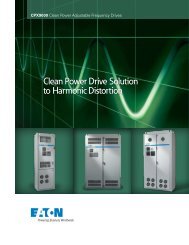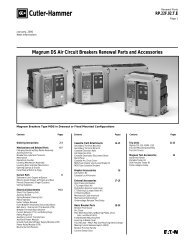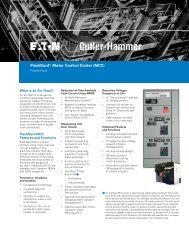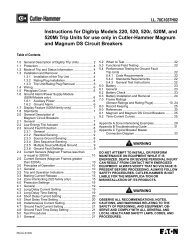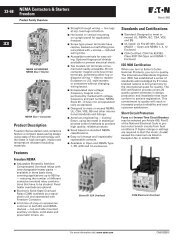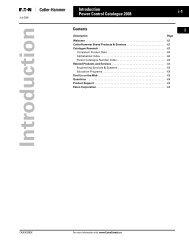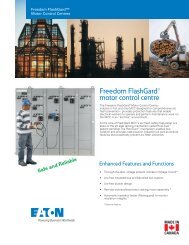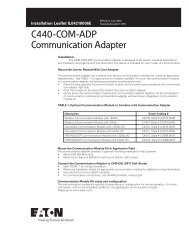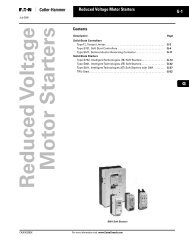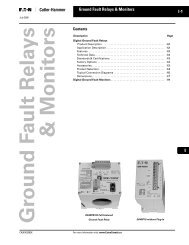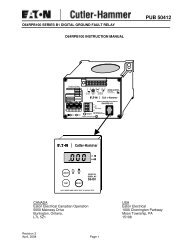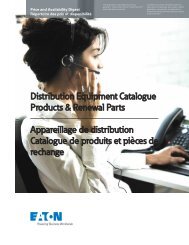Cutler-Hammer - Eaton Canada
Cutler-Hammer - Eaton Canada
Cutler-Hammer - Eaton Canada
Create successful ePaper yourself
Turn your PDF publications into a flip-book with our unique Google optimized e-Paper software.
AF93/IS903 Parameter Descriptions<br />
USING THE PARAMETERS<br />
Remote Function<br />
Specifications<br />
Parameter Number: 23<br />
Mnemonic: REMOTE FUNCTION<br />
Range of Adjustment: ÒSPEED FOLLOWERÓ or<br />
ÒPI REGULATORÓ or<br />
ÒANALOG LOAD LIMÓ or<br />
ÒDIGITAL POTÓ<br />
Run Locked?: Yes<br />
Factory Setting: ÒSPEED FOLLOWERÓ<br />
When your drive is in REMOTE mode, speed is<br />
controlled by one of the these Remote Functions:<br />
ÒSPEED FOLLOWERÓ, ÒPI REGULATORÓ,<br />
ÒANALOG LOAD LIMÓ or ÒDIGITAL POTÓ.<br />
A discussion about the priority interaction among<br />
the various signals that can control the motor<br />
speed follows the discussion of each type of<br />
remote function.<br />
ÒSPEED FOLLOWERÓ - You can vary the speed<br />
setpoint using a current or voltage speed follower<br />
input. The speed follower input can be connected<br />
as follows:<br />
¥ If the signal is 4-20 mA, connect it to<br />
terminals 1 and 2.<br />
¥ If the signal is 0-10 VDC, connect it to<br />
terminals 2 and 3.<br />
¥ If the signal comes from a potentiometer,<br />
connect it to terminals 2, 3, and 4.<br />
¥ If the signal is 0-5 VDC, and the output<br />
impedance of the signal follower is less than<br />
or equal to 250 ½ and can output 20 mA,<br />
connect the signal to terminals 1 and 2.<br />
ÒPI REGULATORÓ - You can automatically<br />
maintain a reference setpoint using the ÒPI<br />
REGULATORÓ option. This option incorporates a<br />
feedback signal and reference setpoint. The<br />
following connections are required:<br />
Setpoint - 0-10 VDC, connect it to terminals 2<br />
and 3 (terminal 3 is +) or connect potentiometer<br />
to terminals 2, 3, and 4.<br />
AF93/IS903 Instruction Manual<br />
4-18<br />
Feedback - 4-20 mA connected to terminals 1<br />
and 2. A 0-5 VDC signal can also be connected<br />
to these terminals if the output impedance of the<br />
transducer is less than or equal to 250 ½ and it<br />
can output 20 mA.<br />
PI Regulator Feedback - The feedback signal is<br />
calibrated to provide constant information on<br />
whether the motor is actually running faster or<br />
slower than the setpoint. If the motor is running<br />
faster than setpoint, the drive reduces the<br />
frequency and if the motor is running slower than<br />
setpoint, the drive increases the frequency.<br />
Integral and Proportional Gain - In simple<br />
terms, the Integral Gain parameter controls how<br />
quickly the drive responds to information<br />
provided by the feedback signal and the<br />
Proportional Gain parameter controls how close<br />
to the target value the system will maintain<br />
control. It takes some trial and error in setting<br />
these parameters since some applications have<br />
a natural tendency to favor tight control and<br />
others may start to quickly oscillate around the<br />
target speed the tighter you try to maintain<br />
control.<br />
PI Regulator Application Example - PI is a<br />
closed loop control system consisting of a set<br />
point, a process variable, and an error signal<br />
which will control the drive output. Typical<br />
applications include wet well level control,<br />
temperature or pressure control, or flow rate<br />
control.<br />
PI control starts with a PI Setpoint adjusted by a<br />
remote signal input, such as a potentiometer. The<br />
drive compares the setpoint to a process variable<br />
signal, PI Feedback, and creates an error signal.<br />
The error signal is processed to create the speed<br />
reference for the drive.<br />
In the example shown in Figure 4-1, a pressure<br />
transducer provides a 4-20 mA signal that<br />
corresponds to the duct pressure. The drive will<br />
control the speed of the blower to maintain the<br />
desired duct pressure regardless of the amount of<br />
air flow being supplied through the duct.



